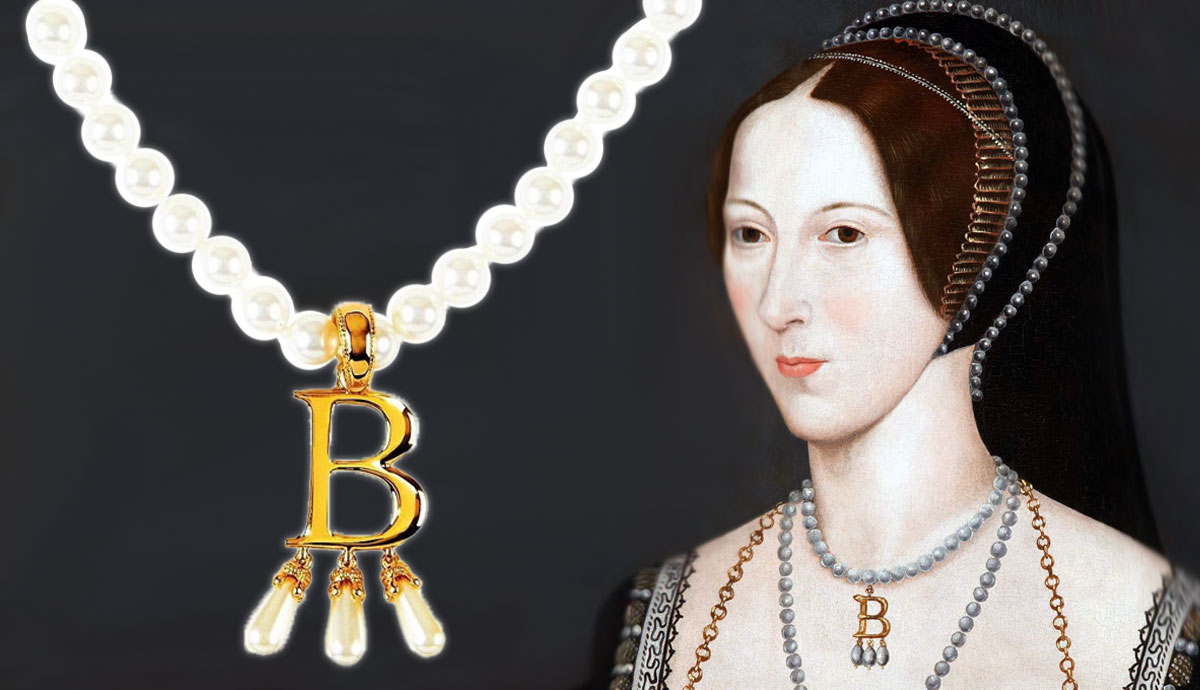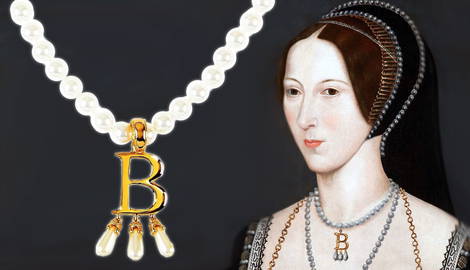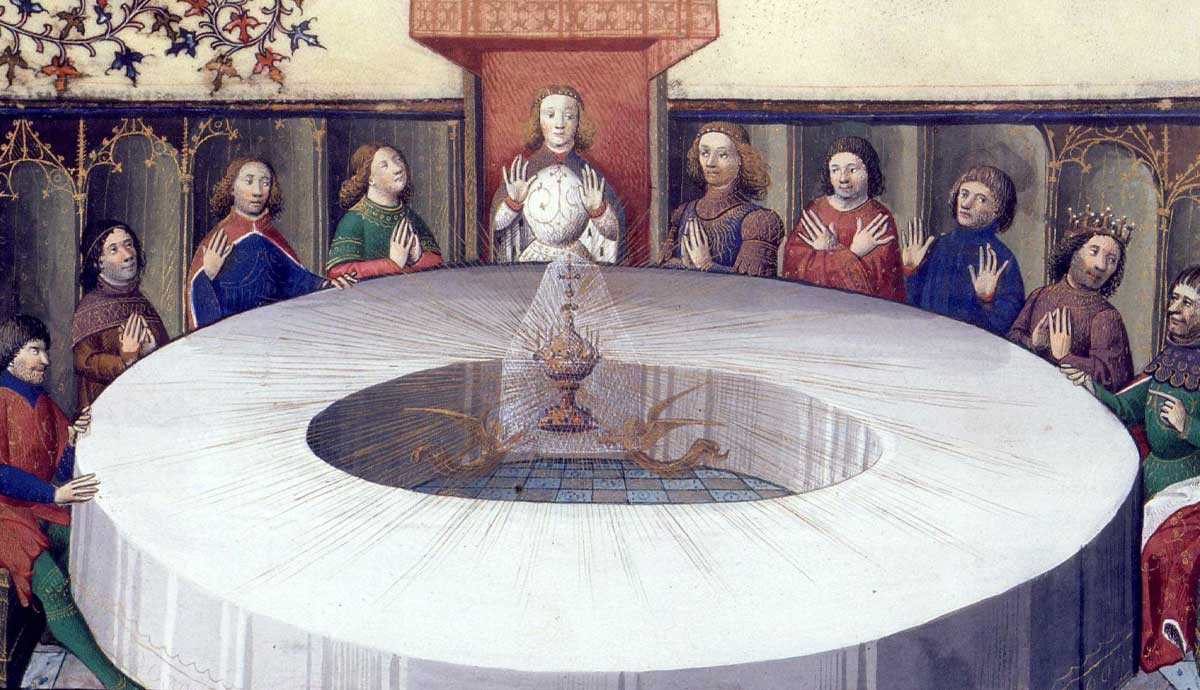
The tale of Anne Boleyn, Henry VIII’s fiercest queen, is as captivating as it is shocking. Despite Henry’s efforts to erase her from history as if she were Nefertiti instead of a woman in the modern era, Anne’s legacy persists — she was, after all, mother to the monarch who ruled over England’s golden age.
Anne left behind both Elizabeth and a range of portraits in which she’s donning her recognizable “B” necklace. This iconic piece of jewelry not only symbolizes Anne’s bold identity but also holds an intractable place in fashion history.
Caught in Love: The Jewels From Henry to Anne

Anne Boleyn, the eldest daughter of the ambassador to the highest court of Austria, was no ordinary woman, and she certainly didn’t let Henry VIII have his way in the manner of many other starstruck women he wooed. Their relationship, tumultuous and electrifying, was as much a power struggle as it was a romance.
Anne knew how high the stakes were in the game of love and power, and she played it well. After all, Anne not only told Henry “no” several times, she fled to the country hoping that his affections would fall on someone else. This however was a case of absence making the heart grow fonder, and Henry simply switched his courtship from one of intense face-to-face interactions to one of notes and gifts.
Henry’s love letters weren’t just sweet nothings; they were wrapped in gold and studded with gems, physical manifestations of a king’s obsession. Anne, ever the fashionista, understood the value of these gifts. They were more than symbols of love — they were tokens of influence.

Among her arsenal of jewels was the famous “B” necklace, an audacious declaration of her identity and status as well as an item long assumed to have belonged to her before King Henry made his bid for her heart. This wasn’t just a piece of jewelry; it was a bold statement, a way of saying, “I am Anne Boleyn, and I will not be forgotten.”
In a world where women’s identities were often swallowed by those of their husbands, Anne’s choice to flaunt her maiden initial was nothing short of revolutionary. It wasn’t just about vanity; it was about legacy. It also said something of her developmental years in the French court, where Anne served as a Lady in Waiting in tandem with Françoise de Foix, Countess of Châteaubriant, herself a fashion-forward icon and symbol of scandal.
Henry’s gifts, too, were strategic, like so much of his maneuvering they had a double meaning. By bestowing Anne with jewels that once graced Catherine of Aragon, he wasn’t merely giving, he was taking away — dismantling his former marriage and setting the stage for his new queen.
The woman he’d been married to for over two decades had been found wanting and in her place would stand Anne, younger, more cosmopolitan, and raised to move in political circles. Anne, who was never accepted by Catherine of Aragon’s daughter Mary, certainly wore the latter’s mother’s jewels in her suddenly diminished presence.
It’s Not Yours, It’s the Crown’s

Anne Boleyn may have captured Henry’s heart, but her hold on the crown’s jewels was always tenuous, much like Catherine’s was. In the ever-shifting world of Tudor politics, jewelry was never just personal — it was political, made for seeing and being seen. When Anne’s star fell, it wasn’t just her head that rolled; her jewels were swiftly reclaimed by the crown, stripped from her as easily as the clothes she had once worn. Both of which, gems and pricey gowns, would go on to adorn the next of Henry’s consorts, the plainer and less quick-witted Jane Seymour.
It was said that Anne had needed no ornaments to shine, her intellect spoke through her dark eyes, but, according to one foreign ambassador, Jane had needed all the sparkling accouterments she could get. The crown’s message was clear: these weren’t Anne’s treasures; they were the monarchy’s, and they would adorn the next queen, and the one after that, all the way down through the line of Henry’s shorter and shorter marriages.
The “B” necklace, that bold emblem of Anne’s identity, vanished into the shadows. Where it ended up next has been cause for speculation and rumor nearly since the day Anne herself was sloppily buried in a shallow grave without a prepared casket or memorial to be had. Whether it still exists or was lost to history, the fate of Anne’s jewels reflects the harsh reality of her life at court — one minute a queen, the next, a cautionary tale.

Henry’s swift reclamation of Anne’s jewels was more than just an act of repossession, it was an attempt to erase her, to control how she would be remembered — or forgotten. But Anne was no ordinary queen, and her memory, much like the pearls she once wore, proved impossible to completely bury. The jewels might have been absorbed back into the royal coffers, but the legend of Anne Boleyn remained, forever entwined with the symbols of her former glory.
Henry would grow to find out that, much like her falcon badge that had been etched into the very walls of the King’s favorite palaces, there was no erasing Anne Boleyn. Did he come to accept this? Is this perhaps why there are whispers that he made efforts in later years to buy back pieces of Anne’s estate that had wandered afar?
After Death, Jewelry Lives On

Anne Boleyn may have been executed, but the jewels that once graced her neck lived on, haunted by the memory of the woman who wore them. These weren’t just trinkets, they were relics, each piece whispering of the ambition, charm, and ruthlessness that defined Anne’s brief yet impactful 1,000-day reign. After her state-ordered demise, her jewelry didn’t simply disappear — pieces were redistributed, recycled, and, perhaps, revered in secret by those who dared to remember the woman who had once brought a king to his knees.
There are whispers that the pearls from Anne’s “B” necklace found their way into the Imperial State Crown. If true, this would mean that a part of Anne still resides at the heart of British royalty, hidden in plain sight. It is a tantalizing thought — that despite Henry’s best efforts to erase her, Anne’s legacy endures, even in the jewels that continue to adorn England’s queens. Another tale is that Anne gave the treasured “B” necklace to her sister, Mary, who would save it for an older, more socially aware Elizabeth.
Jewelry, in the Tudor court, was never just for show. It was currency, power, a means of communication in a world where actions often spoke louder than words, a world in which one’s station was a God-granted right. Anne’s jewels, even after her death, continued to carry the weight of her story, of her family legacy. Whether they were melted down, remade, or passed down through secretive hands, each piece carried with it the ghost of Anne Boleyn, a reminder that some women, no matter how hard you try, can never be forgotten.
From Mother to Daughter

Anne Boleyn’s legacy didn’t die with her, it was passed down, quite literally, to her daughter, Elizabeth I. The connection between mother and daughter, though severed by Anne’s execution, was immortalized in the jewelry that Elizabeth wore. It is believed that some of Anne’s pieces, including her iconic “B” pendant, may have been inherited by Elizabeth. For a queen as calculating and image-conscious as Elizabeth, wearing her mother’s jewelry was more than an act of sentiment — it was a statement.
The “AB” pendant, featured in some portraits of Queen Elizabeth, is a clear nod to her Boleyn heritage. In a court where every detail was scrutinized, this was no casual choice. By wearing her mother’s initials, Elizabeth wasn’t just honoring Anne’s memory, she was asserting her lineage, reminding everyone that she was the daughter of a queen who had once redefined the power dynamics of the Tudor court. If looked at closely, Elizabeth’s famed teenage portrait depicts her in a necklace with a golden badge from which drips three very familiar pearls, pearls quite similar to the ones that once graced Anne’s famed “B” necklace. Did Elizabeth change the setting but keep the valued pearls together in memory of her mother?
Elizabeth was nothing if not strategic, and her choice to embrace her mother’s legacy, rather than distance herself from it, was a masterstroke. In a world where women were often defined by their male relatives, Elizabeth’s decision to wear a pendant bearing Anne’s initials was an act of defiance, a declaration of independence, and a subtle yet powerful assertion of her right to rule. Through the jewelry she wore, Elizabeth ensured that Anne Boleyn’s story would live on, not just as a tragic figure but as the mother of one of England’s greatest monarchs.
Keeping Their Names

Anne Boleyn and Katherine Parr were women who understood the power of identity in a world that sought to strip it away. For Anne, her “B” necklace wasn’t just a piece of jewelry — it was a banner proclaiming who she was before Henry, a bold declaration of her own name in a court where women’s identities were often subsumed by those of their husbands and his ancestors. Wearing that initial wasn’t just an act of vanity; it was a statement of defiance, a way of saying, “I am Anne Boleyn, and my time will come.”
Katherine Parr, Henry’s sixth and final wife, also understood the importance of name and identity. A learned woman, she used her signature as a means of asserting her independence and intellect. Katherine’s jewelry, much like Anne’s, carried symbols of her identity—her initials and her family crest—reminders that she was more than Henry’s sixth wife. In fact, it was she who included her maiden initials after her royal signature, a silent but unignorable way to be more than Henry’s Queen.
Still Searching: Where’s the B Necklace?

The fate of Anne Boleyn’s “B” necklace is a mystery that continues to captivate historians and treasure hunters alike. Despite countless theories and endless speculation, no one knows for sure what happened to this iconic piece. Was it dismantled, its pearls scattered across the royal collection? Or did it survive, hidden away in some forgotten corner, waiting to be rediscovered?
Some of Anne’s treasures were given, not to her own daughter, but to Henry’s other child, Princess Mary. Inventories, however, do not suggest that the “B” necklace was one of them. Mary must have felt a shocking supremacy. As Anne had once paraded in front of her wearing her own ill-used mother’s gems, now Mary could don her reviled stepmother’s finery posthumously in front of the very daughter that was bastardized after Anne’s execution.
However, many believe it was another wife, Henry’s last wife, who convinced him to release several pieces of Anne’s estate jewels from his coffers so that Elizabeth could have these mementos of her mother. Katherine Parr was famously attached to Elizabeth, a veritable second mother, and it is easy to imagine that she would have advocated for Elizabeth’s cause to have something of her mother’s to hold on to.
The search for the “B” necklace is more than just a hunt for a lost piece of jewelry — it is a quest for a connection to one of history’s most compelling figures and her short time as England’s most prominent woman. Whether it’s hidden in a royal vault, lost to history, or still adorning the head of British royalty, the mystery of the “B” necklace ensures that Anne Boleyn’s story is far from over. Even in death, Anne remains a figure who defies easy categorization, her legacy as elusive and yet meaningful as the jewels she once wore.
All Over the World: How We Still Honor Anne in Jewelry

Anne Boleyn may have lived over 500 years ago, but her influence is still felt today — especially in the seemingly unrelated worlds of fashion and faith. The “B” necklace, once a symbol of Anne’s defiance and independence, of her wealth in her own right, has transcended its original context to become a modern-day emblem of feminine strength and resilience.
From high fashion runways to popular television series, Anne’s style continues to inspire, proving that she is more than her terrible and untimely death at the hands of someone meant to love her. In recent years, the “B” necklace has made a comeback, worn by women who see in Anne a kindred spirit — someone who was unapologetically herself, even in the face of overwhelming odds.
Actresses like Natalie Portman and Jodie Turner-Smith have brought Anne’s story to life on screen, each donning their own version of the famous pendant, reminding us all that Anne’s legacy is as relevant today as it was in the 16th century. Her story is one of a Protestant reformer, a woman willing to break with convention (she showed her hair in that French hood, something women hadn’t done in the courts of England for years), who did it all while turning heads each time she passed by.
The enduring appeal of Anne Boleyn’s jewelry lies in its symbolism. These pieces are more than just accessories; they are statements of identity, staying power, and feminist rebellion. By wearing a “B” necklace, women today connect with a legacy of unapologetic ambition, of motherhood through trials unfathomable. In this way, the jewelry associated with Anne Boleyn serves as a bridge between the past and the present, a reminder that history is never truly forgotten as long as we continue to honor and reframe it.











